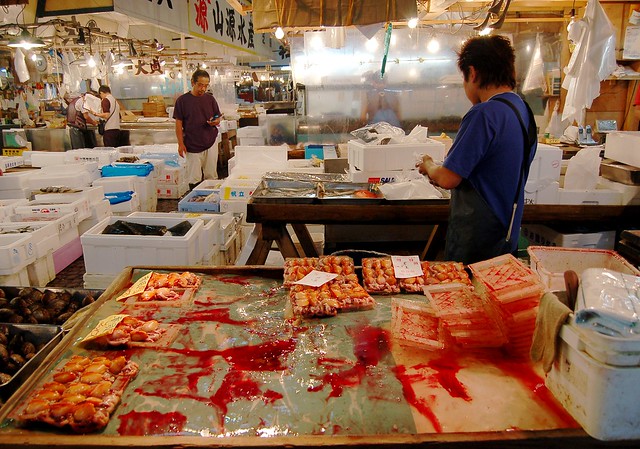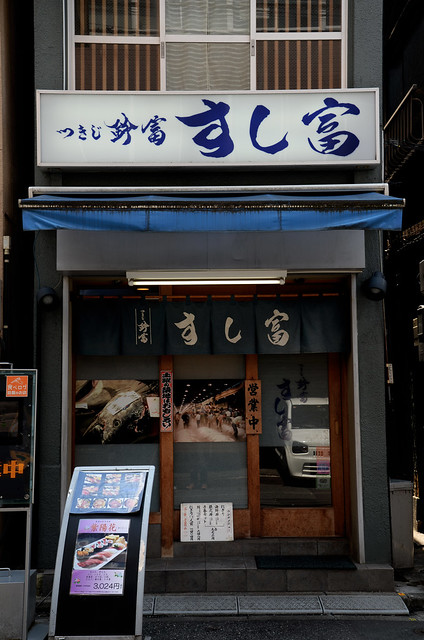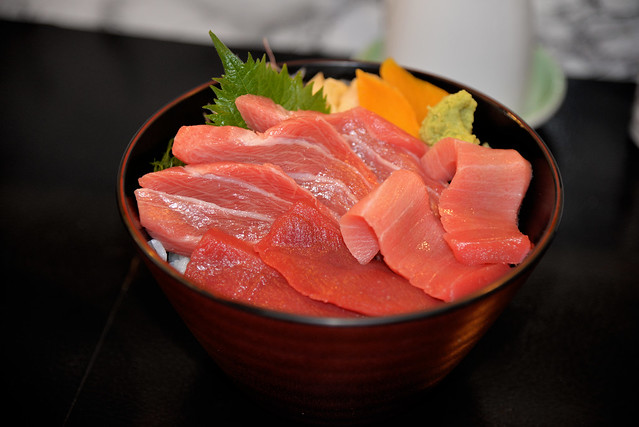June 26, 2006
Almost every time I am in Tokyo I would invariably find myself waking up extremely early at least once, and this time was no exception. Perhaps my body knows one of my favourite things to do in Tokyo is to visit the Tsukiji Market, which is at its busiest every morning from 4 – 7 am. After a long flight from Vancouver I could use some more sleep, but in my mind there wasn’t really a choice.
For all its popularity, the Tsukiji Market is not designed as a tourist attraction. It is the biggest wholesale fish and seafood market in the world, employing tens of thousands of people. Bypassing the crowded outer market where most of the tourists lingered, I headed to the inner market where the distributors and wholesalers were frantically preparing the day’s stock. I could identify less than 10% of the creatures being sold. As vehicles and people constantly flashed by, I became acutely aware of my whereabouts to avoid getting in the way of the ceaseless flow of activities and movements. Just being there gave me a kick similar to drinking a large cup of coffee.
My constantly alert state drained my energy quickly and my stomach signaled to me that it was time to grab some food. I ditched the popular Sushi Dai and Sushi Daiwa and their associated long queues. Instead, I chose a random sushi shop in Zone 6. The bill came higher than expected, but it was not everyday I could have fresh sushi for breakfast.
Tsukiji Market is one of the most unique places in Tokyo; its scale and activity level is one of a kind. Moreover, due to the market’s oft-rumored relocation plan, I treat every visit as potentially my last.
June 15, 2017
I never imagine Tsukiji would still be around in 2017. On my last visit 11 years ago I thought for sure I had bid my farewell, but here it is, still bustling with people while the new location remains tainted with toxins and controversy. Heck, due to constant drumming of the market’s imminent demolition by the media (there is even a documentary), Tsukiji has become arguably Tokyo’s number one attraction, a place everyone has to visit before it is too late. This sentiment certainly existed back in 2006, but now it has gone mainstream, like Disneyland with fish.
Tsukiji wasn’t on my itinerary this time, but as it was only two subway stops away from Ginza we decided to pop by on our last morning in town for a quick kaisendon breakfast. Blessed with too many choices, the only popular consensus is to stay away from Sushi Dai and Sushi Daiwa. Each person seems to have their own favourite, and after asking around for recommendations I went with Sushi Tomi due partly to its relatively solid Tabelog reviews.
I ordered the tekkadon with chutoro and otoro, a much more fancier version of the regular one that only comes with meguro. Expectedly fresh, even the leanest portion was very tender while the belly parts immediately melted in the mouth. At ¥2,916, the price was definitely inflated and I know many places in town could offer this quality at a discount, but eating at Tsukiji is partly a quality assurance and part tourist experience.
Walking back outside, I couldn’t budge into the outer market’s main strip where many of the popular shops are located. The crowd resembled the worst of weekend Causeway Bay’s and it was only 10 am on a weekday morning. Many of the shops now only cater to tourists, along with two new buildings dedicated solely to this cause. The time when anyone could just budge into the inner market and wander around is long gone; the bustling wholesale section has become less permissive of tourists with numerous “No photo” signs glued to the walls.
Reading again my thoughts on Tsukiji from 11 years ago, I am surprised how much I revered the market. It is bemusing — my naivete that I could understand this place in a hour’s time. A decade is not a short time; I have become more jaded in the meanwhile, but no matter what happens to Tsukiji going forward, I will always have that memory of my youth intersecting with this giant market, however temporary it was.


